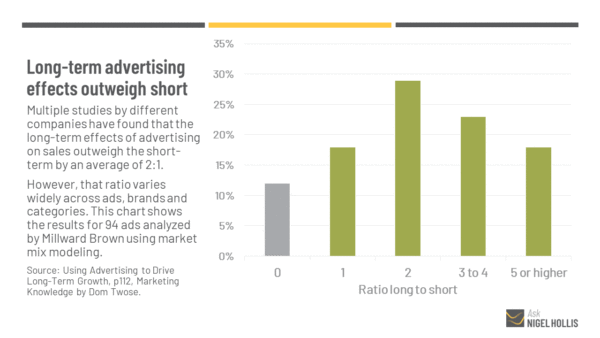Are we underestimating the long-term effects of advertising?
July 11, 2023

By Nigel Hollis
I am sure that is true, but does econometric modeling capture all those indirect effects? No matter how sophisticated the model, I suspect much of the indirect, multiplicative effects of advertising go unmeasured.

For years, smart econometricians have realized that they were missing out on the longer-term effects of advertising. Decaying media exposure over time using adstocks with a half-life measured in weeks captured the short-term effects of advertising. However, those effects rarely pay for the cost of advertising, particularly for low-cost product categories, so the hunt was on for a way to measure longer-term effects.
Occasionally, longer-term effects could be inferred when a change in campaign or other marketing variable resulted in a change in base sales (the proportion of sales not explained by the effect of short-term marketing activities and other relevant variables like seasonality or price). addinghard-nosed financial types usually want more than inference, and so the hunt continued, using a variety of different techniques including adding a second set of adstocks with a longer carryover or adding in brand metrics to capture any equity effect.
Typically, long-term effects are greater than short
Given the state of the art, what do we know about long-term effects today?
As noted by Les Binet in his presentation for the IPA, estimates of the long-term effect of advertising vary. He presented a chart from Meta’s 2022 analysis that found on average long-term effects contributed 60% of the total ROI across 43 brands, intriguingly close to the 60/40 from his own IPA analysis. The analysis also highlights that, as used today, some media channels are better at generating long-term effects than others. However, these are the overall results and as Meta’s report states,
“The size of the long-term effect varied by industry, ranging from 42% in CPG to 76% in Tech & Durables.”
This makes sense, because the inter-purchase interval for most tech and durables is far longer than for CPG, so if advertising does have an influence, it takes longer to see its effects. Les Binet also presented a summary created by LinkedIn of different studies reporting the ratio of long to short-term effects, ranging from 2 to 14. Unfortunately, the findings from Millward Brown in that summary are misrepresented as a ratio of 6, when in fact that was the finding for just one campaign.
To set the record straight I have reproduced the chart above based on an old Millward Brown Knowledge Point (you can find the full Knowledge Point in Dom Twose’s book, Marketing Knowledge). Like the Meta analysis, the Millward Brown ratio varied by brand and category. No long-term effect was detected in 12% of cases and multiples ranging from 1 to 5 and higher were identified for the remainder. If you calculate what the overall ratio of long to short might be from the Millward Brown data it comes out at about 65/35. Call it serendipity or convergence, but that ratio of about 2 to 1 long to short does seem to show up a lot!
Why might we still be underestimating the long-term effects?
- Most marketers would probably settle for a 2 to 1 ratio and call it a win, so why do I think we might still be underestimating the longer-term effects? Three reasons, each related to the others.
- Most of these models only look at sales effects, and advertising has wider effects beyond incremental sales.
- Most models impose some time frame on the period of analysis, usually 2 or 3 years. If you are analyzing a product category like automotive, that time frame could represent only a third of all likely sales, given how often people buy a new car.
- If advertising increases the brand’s penetration by bringing in new buyers, we can expect an additional Double Jeopardy effect on retention. Then, over the long, long term we can expect advertising to help trigger positive network effects, that help build the brand’s power in both the mind and marketplace.
The direct effects of advertising
Here are five ways that advertising can have a direct effect on brand performance,
Improved acquisition
All brands need to recruit new buyers, some to replace those lost to competitors or time, and some to help grow the brand’s market share. Effective advertising works to influence future buyers, making the brand more salient and so more likely to be considered for purchase when people enter the market.
Improved customer retention
Although not as big a driver of growth as acquisition, keeping more than your fair share of buyers over time will help a brand grow (if only because a greater proportion of new buyers are incremental). Advertising helps keep a brand salient to its existing buyer base, reinforces perceptions derived from positive experiences, and “dulls” the influence of competitive marketing.
Stronger sales activation
There is a lot of evidence finding that when brand advertising is effective, sales activation and performance marketing yield greater returns. Why? Because ideas and impressions gained while not researching or shopping a category prime people to choose the advertised brand when they do start the buying process. Search and sales activation then act as signposts not persuasion.
Decreased price elasticity
To my mind this is likely the biggest impact that advertising has on profit. A tiny price advantage spread across thousands of sales soon ads up. Binet and Fields IPA analysis finds that price effects depend on brand building, take time to accumulate, but have a big impact on profit. Analysis of Kantar Worldpanel data by M. Berk Ataman, Koen Pauwels, Shuba Srinivasan, and Marc Vanhuele comes to a similar conclusion.
Improved stakeholder relationships
Resellers, the brand’s own sales force, new hires and existing staff, vendors, banks and insurance companies, governments. Advertising is an important signal of confidence to both consumers and stakeholders alike. I remember a client questioning the results of attitudinal tracking research that found their advertising ineffective, citing a rise in sales reported by Nielsen. It turned out the Nielsen data also showed that many retailers had put the brand on display in anticipation of the advertising taking place. Consumers had not noticed the advertising, but they had noticed the displays, and more bought the brand as a result.
The indirect, network effects of advertising
In a 1996 HBR article, W. Brian Arthur described network effects as follows,
“(Network effects) are mechanisms of positive feedback that operate—within markets, businesses, and industries—to reinforce that which gains success or aggravate that which suffers loss.”
Advertising is just one way in which a brand might generate positive network effects and will likely work best in conjunction with product innovation, changes in strategy, or increased physical availability. In most product categories, paid advertising is necessary to realize the full benefits of innovation, positioning, and wider distribution. Most people do not spend their time following the latest brand news, even when it comes to brands like Apple, Nike, or Tesla. At any point in time, most people have no need for your category and no interest in your brand, which is why advertising and PR are important means to make sure future buyers do notice what is going on.
Supply-side effects
If advertising helps a brand grow its market share, then we can expect a predictable increase in overall retention as a result. This is the law of Double Jeopardy in action. Big brands get more repeat purchases than small ones.
The improvement in retention is driven by both supply-side and demand-side effects. The bigger a brand becomes the more likely retailers and resellers will want to stock it and give it preference over smaller brands. This makes the brand easier to find and so makes the brand an easy choice for existing buyers and new category entrants, triggering increases in retention and stronger network effects, some of which will include wider stakeholder effects, like the ability to get financing at lower rates because bigger brands are a less risky investment.
Demand-side effects
If nothing else, on the few occasions that they think about it, existing brand users want to believe that they are using the right brand, because otherwise they were wrong to make the decision they did and will have to do more due diligence next time around. Provided the advertising they see is consonant with their own experience, it will help reinforce the positive attitudes that make users more likely to buy again. Big brands also get positive reinforcement from the herd effect. They are more likely to be seen, more likely to be talked about, more likely to be recommended, not because they are inherently better than competitive brands, but because they have more users.
Can we estimate the network effects of advertising?
I doubt we can build all these indirect, long-term effects into an econometric model with any real accuracy. Variables like price and distribution are mostly built into models as explanatory variables, which they are in the short-term. Models can be constructed to look for interaction effects between variables, but how many are constructed to look for long-term, network effects? I suspect few, correct me if I am wrong.
Maybe we must take another approach. It should not be beyond the capability of people smarter than me to build Double Jeopardy effects into a brand-level model. The relationship between brand size and retention is usually consistent across brands within a category (or price level). If you can identify short and long-term sales effects and translate it into incremental market share, could you not then calculate what the additional retention effect might be? I would guess we could add a further 50% to the current total, measured advertising effects. Maybe this sort of analysis is already being done. If so, please let me know.
To capture long-term effects your advertising must be effective
Whatever the state of modeling advertising sales effects is concerned, I feel duty bound to state that advertising only works in the long-term when it builds brand memories. As the Millward Brown data highlights, long-term effects are not guaranteed. For 1 in 10 brands the long-term effects were so small that they were not detectable. There are several reasons why that might be so, but most likely it was simply that the advertising did not build what we used to call brand-linked memorability.
If advertising is to have a long-term effect, it must help future buyers think of and/or recognize the brand when a need the brand can solve arises. If it can also leave the impression that the brand is a more effective solution than other options, so much the better. And, to have a long-term effect advertising needs to reach beyond the brand’s existing footprint to influence new buyers, people who have yet to enter the market, and people who are yet to be disappointed with their existing choice. Memorable, branded creative and wide reach are the two main drivers of long-term advertising effects. Combined they will generate sales and wider effects that last well beyond the period of advertising, even if we cannot measure the total effect with any accuracy.




























